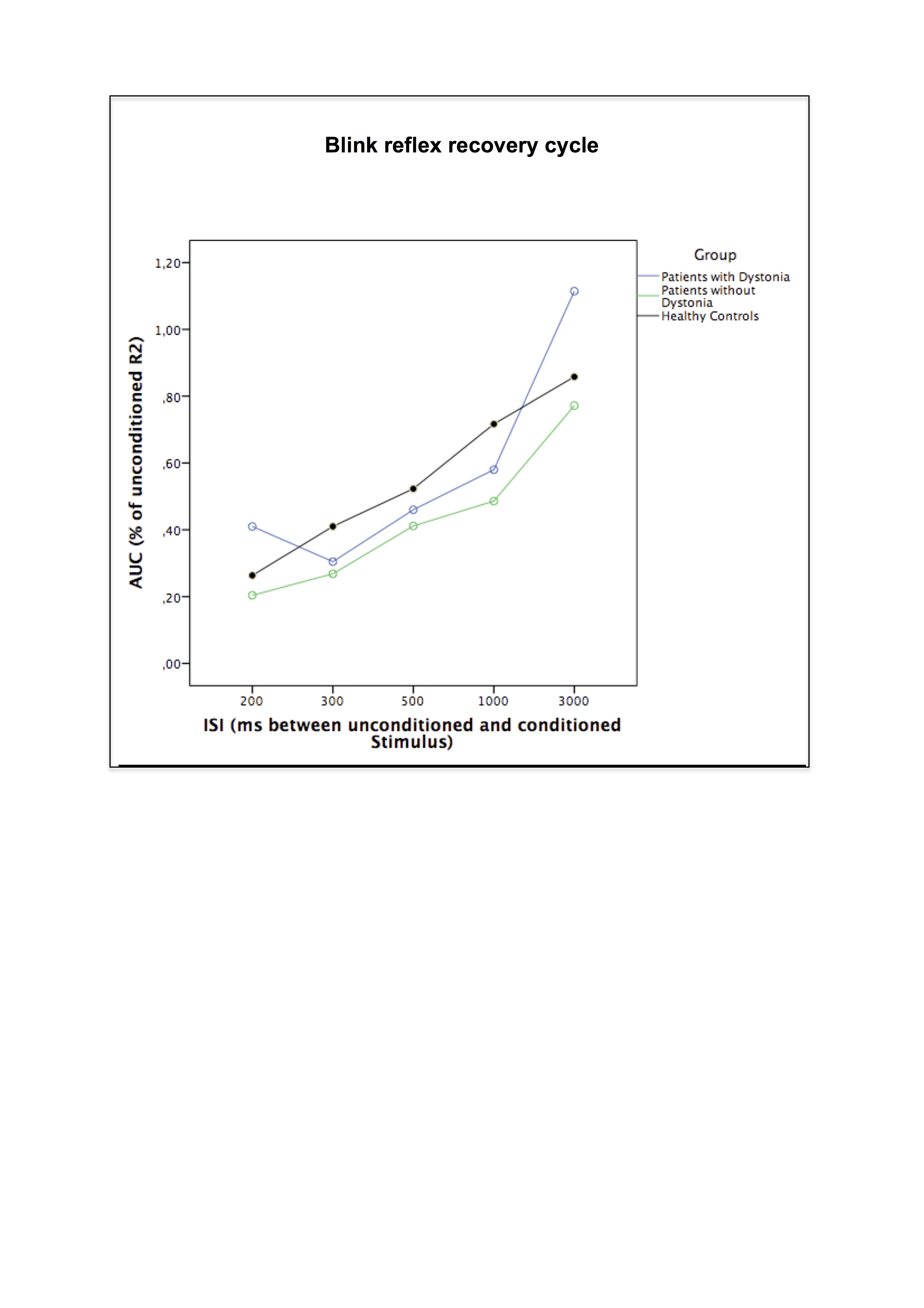Session Information
Date: Wednesday, June 7, 2017
Session Title: Ataxia
Session Time: 1:15pm-2:45pm
Location: Exhibit Hall C
Objective: To investigate the R2 blink reflex recovery cycle (BRRC) in genetically determined ataxias such as spinocerebellar ataxia (SCA), ataxia telangiectasia (AT) and Friedreich”s ataxia (FRDA).
Background: BRRC is known to be facilitated (enhanced) in movement disorders with basal ganglia involvement including Parkinson’s disease and isolated focal dystonias.(1, 2) The underlying mechanism though is not yet fully understood.
Methods: In an ongoing study, 22 patients (7 SCA1, 1 SCA2, 5 SCA3, 4 SCA6, 1 SCA17, 1 AT, 3 FRDA) with and without dystonia and 28 age and sex-matched healthy controls (HC) were examined. The BRRC was investigated using an air-puff stimulation at interstimulus intervals (ISI) of 200, 300, 500, 1000, and 3000 msec. EMG was recorded from the right orbicularis oculi muscle. To compare individual subjects, the area under the curve ratio values of R2 conditioned/R2 unconditioned were calculated. Clinical examination included a standardized video protocol and rating scales (e.g. scale for the assessment and rating of ataxia (SARA) and Fahn-Marsden-Score for Dystonia). For statistical analysis patients were grouped into those with (n=9) and without dystonia (n=13).
Results: The BRRC differed significantly (p<0.001) between the five ISI with stronger inhibition at shorter ISIs. Surprisingly, patients showed a trend towards a stronger inhibition of the BRRC (29% vs. 41% for ISI 300; 53% vs. 72% for ISI 1000) compared to HC. The analysis of patients with and without dystonia revealed a significant interaction (p=0.05) of the factors group and ISI (Figure 1).
[figure1]
Conclusions: To our knowledge, this is the first study investigating the BRRC in genetically defined ataxia patients. So far, in patients with Parkinson’s disease and isolated dystonias the BRRC was facilitated suggesting deficient inhibition of basal ganglia – brainstem interaction mediating this response. In contrast, in ataxia patients reported here, there was a significant interaction of the factors group and ISI and a tendency towards stronger inhibition of the BRRC. Our ongoing investigations will clarify, if this effect withstands to significance and whether other clinical markers such as SCA subtype or symptom severity correlate with our electrophysiological findings.
References: 1. Schwingenschuh P, Katschnig P, Edwards MJ, et al. The blink reflex recovery cycle differs between essential and presumed psychogenic blepharospasm. Neurology 2011;76:610-614.
2. Nistico R, Salsone M, Vescio B, et al. Blink reflex recovery cycle distinguishes essential tremor with resting tremor from de novo Parkinson’s disease: an exploratory study. Parkinsonism Relat Disord 2014;20:153-156.
To cite this abstract in AMA style:
S. Tunc, A. Weissbach, E. Werner, N. Baginski, J. Lubs, A. Münchau, T. Bäumer. Blink reflex recovery cycle in patients with genetically determined ataxias [abstract]. Mov Disord. 2017; 32 (suppl 2). https://www.mdsabstracts.org/abstract/blink-reflex-recovery-cycle-in-patients-with-genetically-determined-ataxias/. Accessed December 23, 2025.« Back to 2017 International Congress
MDS Abstracts - https://www.mdsabstracts.org/abstract/blink-reflex-recovery-cycle-in-patients-with-genetically-determined-ataxias/

